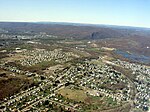Red Spring Run
Rivers of Luzerne County, PennsylvaniaRivers of PennsylvaniaTributaries of the Lackawanna River
Red Spring Run (also known as Red Springs Run) is a tributary of the Lackawanna River in Lackawanna County and Luzerne County, in Pennsylvania in the United States. It is approximately 1.5 miles (2.4 km) long and flows through Ransom Township in Lackawanna County and Duryea in Luzerne County. The watershed of the stream has an area of 1.25 square miles (3.2 km2). It is designated as a Coldwater Fishery and a Migratory Fishery. The stream has one unnamed tributary. Many reaches of the stream have been affected by mining and abandoned mines. The surficial geology in its vicinity features alluvium, coal dumps, surface mining land, and Wisconsinan Till.
Excerpt from the Wikipedia article Red Spring Run (License: CC BY-SA 3.0, Authors).Red Spring Run
Coxton Road,
Geographical coordinates (GPS) Address Nearby Places Show on map
Geographical coordinates (GPS)
| Latitude | Longitude |
|---|---|
| N 41.3558 ° | E -75.7655 ° |
Address
Coxton Road
Coxton Road
18642
Pennsylvania, United States
Open on Google Maps








